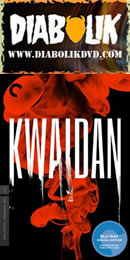
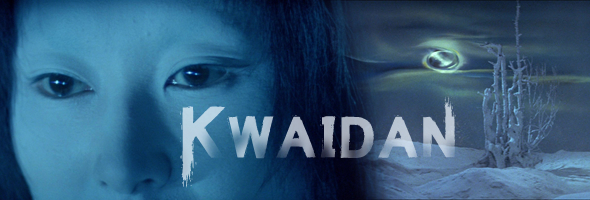
Color, 1965, 183/161m.
Directed by Masaki Kobayashi
Starring Rentaro Mikuni, Tatsuya Nakadai, Michiyo Aratama, Katsuo Nakamura, Noboru Nakaya
Criterion (Blu-ray & DVD) (US RA/R1 HD/NTSC), Madman (DVD) (Australia R0 PAL), Eureka (UK RB PAL) / WS (2.35:1) (16:9)
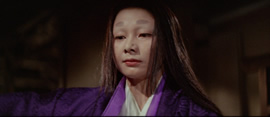
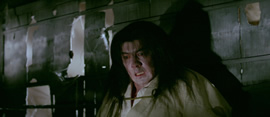 One of the most internationally revered Japanese films (though not initially respected in its home country), Kwaidan is that rare creature, a horror film capable of impressing even the staunchest critics and capable of functioning as a work of art regardless of genre. Based on the oft-translated stories of Greek-born writer Lafcadio Hearn, this quartet of ghost stories caused a sensation when released, racking up awards at Cannes and, along with Onibaba and Ugetsu, introducing English-speaking viewers to an entirely different kind of cinematic terror.
One of the most internationally revered Japanese films (though not initially respected in its home country), Kwaidan is that rare creature, a horror film capable of impressing even the staunchest critics and capable of functioning as a work of art regardless of genre. Based on the oft-translated stories of Greek-born writer Lafcadio Hearn, this quartet of ghost stories caused a sensation when released, racking up awards at Cannes and, along with Onibaba and Ugetsu, introducing English-speaking viewers to an entirely different kind of cinematic terror.
The first story, "The Black Hair," concerns an impoverished samurai (Mikuni) who abandons his wife (Aratama) and rides off to richer pastures. He marries a richer woman but ultimately finds his marriage in ruins. Dejected, he returns to his first wife years later, only to find her exactly the same as he left her. However, the evening spent in her arms takes a decidedly chilling turn. In "The Woman in the Snow," which was trimmed from initial prints and later remade (without credit) in Tales from the Darkside: The Movie, two woodcutters trudging through a snowy forest come across a ghostly woman who kills one them and decides to leave the other alive, only on the condition that he never tell a living soul about their encounter. 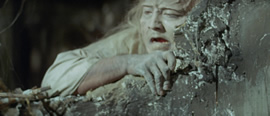 Years pass, and the woodcutter has established a family with a
Years pass, and the woodcutter has established a family with a 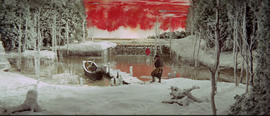 beautiful wife; however, his loose tongue proves to have tragic consequences. In the opulent and unforgettable "Hoichi the Earless," a young blind singer/storyteller named Hoichi (Nakamura) skillfully delivers the saga of warring clans during a sea battle. The ghosts of one clan are so impressed with his skill that they repeatedly summon him to perform for them, a demand which takes too heavy a toll on Hoichi's own spirit. The local priests learn of his plight and cover him with painted holy symbols which will render him invisible to the ghosts. Unfortunately the priests make one slight mistake which yields a gruesome penalty. Finally, "In a Cup of Tea" a writer (Nakaya) looks into a cup of tea and finds a completely different, younger man's reflection staring back at him. That evening the strange apparition appears, causing the frightened writer to attack him. Later three more ghosts appear with a sinister command from their master, resulting in one final, bizarre twist.
beautiful wife; however, his loose tongue proves to have tragic consequences. In the opulent and unforgettable "Hoichi the Earless," a young blind singer/storyteller named Hoichi (Nakamura) skillfully delivers the saga of warring clans during a sea battle. The ghosts of one clan are so impressed with his skill that they repeatedly summon him to perform for them, a demand which takes too heavy a toll on Hoichi's own spirit. The local priests learn of his plight and cover him with painted holy symbols which will render him invisible to the ghosts. Unfortunately the priests make one slight mistake which yields a gruesome penalty. Finally, "In a Cup of Tea" a writer (Nakaya) looks into a cup of tea and finds a completely different, younger man's reflection staring back at him. That evening the strange apparition appears, causing the frightened writer to attack him. Later three more ghosts appear with a sinister command from their master, resulting in one final, bizarre twist.
From the opening images of web-like strands of brightly colored paint slowly twisting through water, Kwaidan is an intense sensory experience. Every frame of the film is perfectly composed and a wondrous feat of color lighting; you could freeze frame at any point and have a stunning image on your television screen. Director Masaki Kobayashi (The Human Condition) displays a remarkable command of the medium here, a huge departure from his gritty earlier work, and the vibrant, unnatural backdrops have influenced several generations of filmmakers both in the East and West. Imagine The Twilight Zone with the scope of 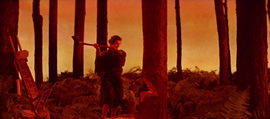 Akira Kurosawa and the visual flair of Dario Argento, and that might convey some of the tone of this unique masterpiece. Though the pace is extremely deliberate and may prove difficult for some viewers, the effort is well worth it.
Akira Kurosawa and the visual flair of Dario Argento, and that might convey some of the tone of this unique masterpiece. Though the pace is extremely deliberate and may prove difficult for some viewers, the effort is well worth it. 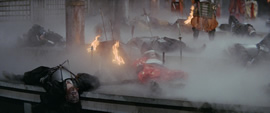
Kobayashi spent years putting the film together story by story, using an aircraft hangar to construct the massive sets and getting his budget piecemeal as each tale was produced. His initial cut came in at 183 minutes but was deemed too long, especially for consideration at the Cannes Film Festival that year where anything over two hours was disqualified from exhibition. He reluctantly trimmed the film down to 163 minutes, but that was still disallowed and the second story had to be cut in its entirety. Kobayashi went on to win the Special Jury Prize at the festival anyway, and that drastically shortened version (just over two hours) was issued with English subtitles by Continental Distributing in the United States, where it earned an Oscar nomination for Foreign Language Film. The longer 161-minute cut played in a handful of territories including Japan and first surfaced on American home video in a letterboxed VHS transfer from Sinister Cinema, eventually withdrawn when officially licensed versions from Toho started popping up.
Someone at Criterion must really love Kwaidan since they've have always had excellent source materials in every format starting with VHS (courtesy of Home Vision) and laserdisc. The scope framing is vital to appreciating this film, and the best presentation of the 161-minute version (which was restored just before Kobayashi's death in 1996) remains the 2004 Criterion DVD which features a color palette that can only be described as hallucinatory. Apart from some very minor scratches near the reel changes, the print is in wonderful condition. The mono audio sounds fine, with the excellent, experimental score by Tôru Takemitsu (Ran) filled with bizarre, atonal rumblings of bass and high treble shrieking. The English subtitles have reportedly been retranslated 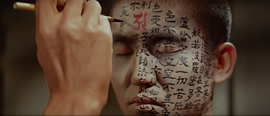 and improved, but the variations appear to be minor. The disc also includes the original Japanese trailer (with optional subtitles) but, strangely, no background information on the film or its participants to put it in any historical context, with only a brief liner notes essay covering the very basics.
and improved, but the variations appear to be minor. The disc also includes the original Japanese trailer (with optional subtitles) but, strangely, no background information on the film or its participants to put it in any historical context, with only a brief liner notes essay covering the very basics. 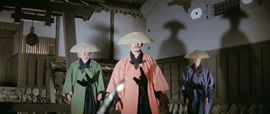
Things got much more interesting two years later in early 2006 when the previously unreleased 183-minute cut turned up on Australian DVD in a no-frills release from Madman, looking even better courtesy of a restored transfer from the Toho vaults. Later that year, British label Eureka bowed the same complete version on DVD along with a 72-page illustrated book featuring the original short stories, a Kobayashi bio by Linda Hoaglund, and the last text interview the filmmaker granted.
Flash forward another nine years, and the uncut version finally bowed on U.S. home video from Criterion courtesy of a greatly expanded Blu-ray as well as a DVD reissue (separate releases sharing the same extras). Happily, the Blu-ray looks absolutely incredible with a gorgeous representation of the film's bold, diverse color palette; no crazy color timing tinkering going on here, thankfully, and the original, very fine grain structure has been left intact. The lossless Japanese mono audio also sounds fantastic with the sparing music piercing through just fine.
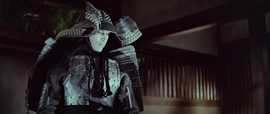
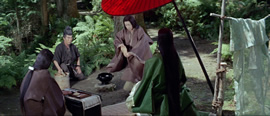 The biggest extra here is a new audio commentary by film historian Stephen Prince, who manages to keep dishing out info about the film for the entire three-hour running time. He goes into a lot of detail about Hearn and the tradition of Japanese ghost story literature, the themes of Kobayashi's films and the stylistic departure he embarked on here, and the rampant color and seasonal symbolism in each story. He starts off with a halting speaking style as if he's reading cue cards for the first story, but he eventually loosens up as it goes along and makes for a fine audio companion. The release also contains a trio of substantial video extras, and first up is a 1993 interview with Kobayashi conducted by director Masahri Shinoda for the Directors Guild of Japan. Running 15 minutes, it covers such topics as his collaborations with Takemitsu, his efforts to push stylization as far as he could with this film after Harakiri, the incredibly long production process, and the creation of the color schemes from the backdrops to the costumes. Assistant director Kiyoshi Ogasawara appears for a new 21-minute interview called "The Highest Standards" chatting about the source material, the makeup process, the recurring theme of human sadness running under the horrific tales, and the restoration of the original full-length cut. Finally, literature scholar Christopher Benfrey tackles the legacy of Hearn in a 17-minute piece called "The Ancient in the Modern" about his influences including Poe and how he presented Japanese folklore traditions for worldwide ghost story readers. Finally the disc rounds out with one black-and-white teaser ("Japan's biggest sound stage! Filming is going smoothly!") and two excellent color trailers. The release also comes with a liner notes essay by Geoffrey O'Brien, who notes the film's relationship to Japanese art and theater and offers a take on its themes including broken vows and the barriers of the human world.
The biggest extra here is a new audio commentary by film historian Stephen Prince, who manages to keep dishing out info about the film for the entire three-hour running time. He goes into a lot of detail about Hearn and the tradition of Japanese ghost story literature, the themes of Kobayashi's films and the stylistic departure he embarked on here, and the rampant color and seasonal symbolism in each story. He starts off with a halting speaking style as if he's reading cue cards for the first story, but he eventually loosens up as it goes along and makes for a fine audio companion. The release also contains a trio of substantial video extras, and first up is a 1993 interview with Kobayashi conducted by director Masahri Shinoda for the Directors Guild of Japan. Running 15 minutes, it covers such topics as his collaborations with Takemitsu, his efforts to push stylization as far as he could with this film after Harakiri, the incredibly long production process, and the creation of the color schemes from the backdrops to the costumes. Assistant director Kiyoshi Ogasawara appears for a new 21-minute interview called "The Highest Standards" chatting about the source material, the makeup process, the recurring theme of human sadness running under the horrific tales, and the restoration of the original full-length cut. Finally, literature scholar Christopher Benfrey tackles the legacy of Hearn in a 17-minute piece called "The Ancient in the Modern" about his influences including Poe and how he presented Japanese folklore traditions for worldwide ghost story readers. Finally the disc rounds out with one black-and-white teaser ("Japan's biggest sound stage! Filming is going smoothly!") and two excellent color trailers. The release also comes with a liner notes essay by Geoffrey O'Brien, who notes the film's relationship to Japanese art and theater and offers a take on its themes including broken vows and the barriers of the human world.
Reviewed on October 14, 2015.












